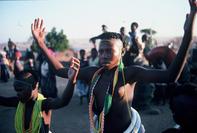Symbolic Beliefs
For the Ntwana, rain is not merely the physical source of regeneration. It is also the symbol of spiritual fertility and a sign that nature and society are in harmony. In order to ensure the smooth continuation of the cosmic order, rainmaking rites are held annually.

Before this event, the rain is invoked through the symbol of the lightning bird (tladi). Widely believed to be a Cape fish eagle, this bird is distinguishable by its red, white and black feathers. It is believed that the lightning bird is trapped within an object called the lehadima, an ox horn decorated to resemble a bird with red, white and black concentric circles.
The lehadima is used extensively by male and female diviners (ngaka or mapale) to invoke the rain which will ensure the fertile regeneration of both the land and the community. The Ntwana have contradictory attitudes towards symbols of fertility. For example, the colour red is regarded both as a sign of fecundity and danger.
Lightning is regarded as the harbinger of rain, yet the Ntwana also believe it may be trapped by witches and misdirected in order to subvert the natural fertile order of life. Likewise, women, who are responsible for the overall fecundity of both land and womb, are also regarded as potential threats to the prosperity of the community.
This ambivalence is highlighted by the relationship between women and cattle. Both are identified with and stand in opposition to one another. Both are symbols of fertility and both represent a threat to each other's procreative powers.
For example, menstruating women are barred from the cattle enclosure. The reason for this is that, if a barren women enters the enclosure, an identical state will befall the cattle. Women are regarded as 'safe' only after menopause, when they discard all of their beaded waistbands, except for the lowest pink band. If pink is taken as representing a combination of red and white, the colour signifies sexual and, by implication, mystical neutrality.
This suggests that the Ntwana construct a very intricate, often ambivalent, relationship between particular colours, objects and the elements essential for their survival in both mystical and physical spheres. Colours are associated with states of heat and coolness, purity and danger, which serve to provide the Ntwana with a symbolic language that helps to make sense of a world which is often perceived as unintelligible, hostile and in a constant state of flux.